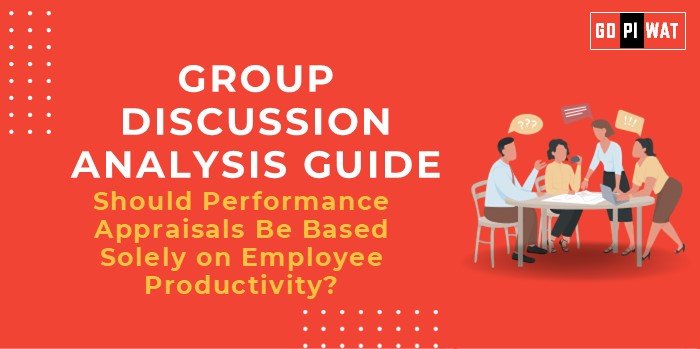📋 Group Discussion (GD) Analysis Guide
🌐 Topic: Should Performance Appraisals Be Based Solely on Employee Productivity?
💡 Introduction to the Topic
- Opening Context: Employee performance appraisals are a cornerstone of organizational development, impacting promotions, bonuses, and overall employee satisfaction. With businesses emphasizing productivity, the debate on whether appraisals should focus solely on this metric remains relevant.
- Topic Background: Traditionally, appraisals consider multiple factors—teamwork, innovation, and adaptability—besides productivity. However, as productivity metrics become more quantifiable through technology, their dominance in appraisal processes has surged.
📊 Quick Facts and Key Statistics
- 📉 Global Workforce Productivity Losses: $7.8 trillion annually due to disengaged employees (Gallup, 2023).
- 📋 Performance Appraisal Usage: 85% of companies use productivity as a primary metric (SHRM, 2023).
- 🤝 Employee Retention and Recognition: 69% of employees feel undervalued when appraisals focus solely on numbers (Harvard Business Review, 2023).
👥 Stakeholders and Their Roles
- Employees: Seek fair recognition for multifaceted contributions, including creativity and collaboration.
- Management: Focuses on measurable outcomes to align with business goals.
- HR Professionals: Develop appraisal frameworks balancing objectivity and holistic evaluation.
- Industry Bodies: Provide guidelines for equitable appraisal practices.
✅ Achievements and Challenges
Achievements:
- ✔️ Encourages accountability and goal alignment through clear productivity metrics.
- ✔️ Simplifies appraisal processes, reducing subjectivity.
- ✔️ Enhances goal tracking using advanced performance management software.
Challenges:
- ⚠️ Risks demotivating employees engaged in non-measurable but critical tasks like innovation.
- ⚠️ Overlooks soft skills and team dynamics critical to long-term success.
Global Comparisons:
- 🌍 Google: Balances productivity with creativity through 360-degree feedback models.
Case Study: A leading IT firm’s shift to productivity-only appraisals led to a 15% turnover increase due to perceived unfairness.
📚 Structured Arguments for Discussion
- Supporting Stance: “Focusing solely on productivity ensures tangible, measurable appraisals aligned with organizational objectives.”
- Opposing Stance: “Reducing performance to numbers undermines vital aspects like innovation and collaboration, harming long-term growth.”
- Balanced Perspective: “While productivity is crucial, appraisals should incorporate other dimensions like teamwork and initiative for a holistic evaluation.”
💬 Effective Discussion Approaches
- Opening Approaches:
- 📊 “85% of companies prioritize productivity in appraisals; is this the best approach?”
- 📋 “Consider the unintended turnover spike in firms over-relying on productivity metrics.”
- Counter-Argument Handling:
- ✔️ “While measurable goals are key, ignoring qualitative contributions risks losing top talent.”
🧐 Strategic Analysis of Strengths and Weaknesses
- Strengths: Promotes accountability and aligns individual and organizational goals.
- Weaknesses: Ignores teamwork and innovation, creating a high-pressure environment.
- Opportunities: Incorporate AI-driven insights for balanced appraisals.
- Threats: Talent drain due to perceived unfairness.
📖 Connecting with B-School Applications
- Real-World Applications:
- Projects on employee engagement and retention strategies in HR and operations.
- Sample Interview Questions:
- “How would you design a fair appraisal system?”
- “Can productivity-only appraisals work in team-based roles?”
- Insights for B-School Students:
- Explore appraisal innovations like AI and 360-degree feedback.
- Investigate industry-specific appraisal challenges and solutions.


